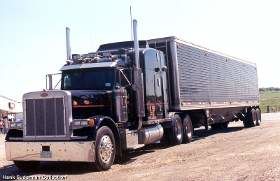Weight Change On Steers When Sliding Trailer
Topic 14284 | Page 2
Hey OS I too had a problem with my steers being over and I fixed it by sliding the tandems. I was almost 13k on my steers and 22k on my drives and 33 on my tandems. I actually had to call and have someone explain to me what to do because we don't have sliding fifth wheels here. Basically since I was so heavy on the trailer tandems it was sort of picking up the drives and therefore placing more weight on the steers. When I balanced out my drive and tandems it fixed the problem on the steers. It only happened that one time and apparently it is something that doesn't happen often because I had to ask 5 different people before I got an answer that fixed it. I will agree tho that normally the weight on the steers doesn't change by sliding the tandems maybe 20 to 40 lbs but nowhere near enough to worry about putting on a spreadsheet.
Now see, that's one of the rare occasions I was talking about. You had a variation of 11k and that's huge. Your steering would be heavy, drives dancing around and it feels like you're dragging the trailer rather than pulling it. Even after a short amount of time in your truck, you'll have a pretty good idea of where to set your tandems before you even scale it out and usually get pretty close. You'll also get a feel for what the whole rig feels like when it's right and you'll know if it feels off.
Tandems:
Tandem Axles
A set of axles spaced close together, legally defined as more than 40 and less than 96 inches apart by the USDOT. Drivers tend to refer to the tandem axles on their trailer as just "tandems". You might hear a driver say, "I'm 400 pounds overweight on my tandems", referring to his trailer tandems, not his tractor tandems. Tractor tandems are generally just referred to as "drives" which is short for "drive axles".
Tandem:
Tandem Axles
A set of axles spaced close together, legally defined as more than 40 and less than 96 inches apart by the USDOT. Drivers tend to refer to the tandem axles on their trailer as just "tandems". You might hear a driver say, "I'm 400 pounds overweight on my tandems", referring to his trailer tandems, not his tractor tandems. Tractor tandems are generally just referred to as "drives" which is short for "drive axles".

Yeah I had only been driving solo for like 3 weeks at the time and was still getting a feel for the truck. I take pride now in being able to look at the weight of the freight and where it ends at and being able to get really close or even dead on for tandem placement. Its always a guessing game when you pick up a preloaded trailer but I can still get pretty close with just the weight of the freight. I can say I will always remember that though in case anyone ever asks me what to do in a situation like that tho.
Tandem:
Tandem Axles
A set of axles spaced close together, legally defined as more than 40 and less than 96 inches apart by the USDOT. Drivers tend to refer to the tandem axles on their trailer as just "tandems". You might hear a driver say, "I'm 400 pounds overweight on my tandems", referring to his trailer tandems, not his tractor tandems. Tractor tandems are generally just referred to as "drives" which is short for "drive axles".

Every time you weigh-slide tandems-reweigh, enter the number of holes you slid and the change in weight on the steers in a spreadsheet row, then when you have enough rows, use the linear regression function to see if there is a linear relationship.
BTW Michael, I agree that there does seem to be at least a small change, and I see where you said in your first post "I know the change will be small". I think I'm a fellow geek who understands why you want to do this even if it's a small change. It would be cool to be able to model the truck so you could write a program to enter the axle weights and have it tell you the best tandem/5th wheel settings to use. But I also know in reality it would be overkill. I only started out 3 months ago and I can usually get close just by looking at how far back the trailer is loaded.
This person gets me. the program is for when you have to weigh on those pesky scales that require a little math to figure out the weight for each axil. I figured, hell, why not have it give me the optimal placement for the holes too. I have had a 700 pound change from steers to drives just by sliding the trailer... only happened once though.
Tandems:
Tandem Axles
A set of axles spaced close together, legally defined as more than 40 and less than 96 inches apart by the USDOT. Drivers tend to refer to the tandem axles on their trailer as just "tandems". You might hear a driver say, "I'm 400 pounds overweight on my tandems", referring to his trailer tandems, not his tractor tandems. Tractor tandems are generally just referred to as "drives" which is short for "drive axles".
Tandem:
Tandem Axles
A set of axles spaced close together, legally defined as more than 40 and less than 96 inches apart by the USDOT. Drivers tend to refer to the tandem axles on their trailer as just "tandems". You might hear a driver say, "I'm 400 pounds overweight on my tandems", referring to his trailer tandems, not his tractor tandems. Tractor tandems are generally just referred to as "drives" which is short for "drive axles".
HOS:
Hours Of Service
HOS refers to the logbook hours of service regulations.New Reply:
New! Check out our help videos for a better understanding of our forum features

















Preview:








 TT On Facebook
TT On Facebook
Hey OS I too had a problem with my steers being over and I fixed it by sliding the tandems. I was almost 13k on my steers and 22k on my drives and 33 on my tandems. I actually had to call and have someone explain to me what to do because we don't have sliding fifth wheels here. Basically since I was so heavy on the trailer tandems it was sort of picking up the drives and therefore placing more weight on the steers. When I balanced out my drive and tandems it fixed the problem on the steers. It only happened that one time and apparently it is something that doesn't happen often because I had to ask 5 different people before I got an answer that fixed it. I will agree tho that normally the weight on the steers doesn't change by sliding the tandems maybe 20 to 40 lbs but nowhere near enough to worry about putting on a spreadsheet.
Tandems:
Tandem Axles
A set of axles spaced close together, legally defined as more than 40 and less than 96 inches apart by the USDOT. Drivers tend to refer to the tandem axles on their trailer as just "tandems". You might hear a driver say, "I'm 400 pounds overweight on my tandems", referring to his trailer tandems, not his tractor tandems. Tractor tandems are generally just referred to as "drives" which is short for "drive axles".
Tandem:
Tandem Axles
A set of axles spaced close together, legally defined as more than 40 and less than 96 inches apart by the USDOT. Drivers tend to refer to the tandem axles on their trailer as just "tandems". You might hear a driver say, "I'm 400 pounds overweight on my tandems", referring to his trailer tandems, not his tractor tandems. Tractor tandems are generally just referred to as "drives" which is short for "drive axles".